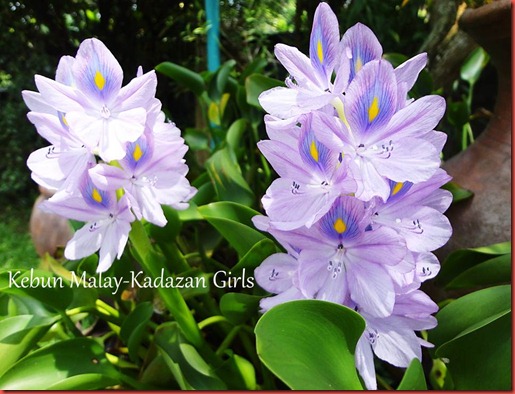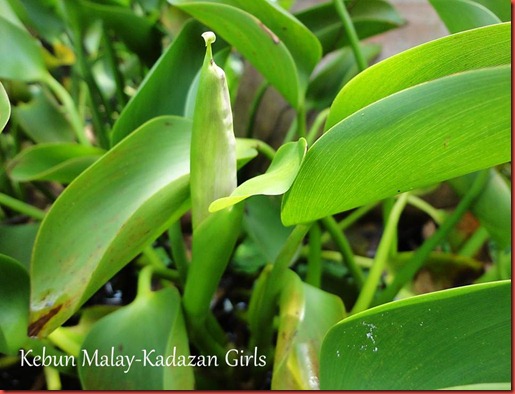
Rice is a staple food in Malaysia. For my babies, I would like them to sample a variety of staple food and not just rice in their diet everyday. Growing home-grown rice is not realistic at the moment and one which I cannot commit while still struggling to complete my thesis, not easy since I can't really started my writing while trying to recover from post-natal and mental depression. I chose another relative of rice which is corn as the first tentative step to grow our own food. Thus this year, I decided to study the soil and weather at our place which is perfect for a successful growing corn requirement in different season and location. Perfect condition meaning I don't have to look after them as I need to be more committed and focus more on my thesis and my three babies which is all under 5 years old. All the plants including corns at the moment only depend on rain water unless we don't have any rain for 3 consecutive days. The first corn we decided to grow since we came back is Baby blue jade heirloom corn.

Baby Blue Jade Corn is a very beautiful mini size corn compare to standard sweet corn size. Baby Blue Jade is about the size of baby corn just fatter and have fat kernels. Therefore, baby blue jade corn is a blue heirloom open-pollinated corn that is suitable for gardeners that have limited spaces to grow their own food. For fun, we did a trial growing baby blue jade corn on a meter square raised bed and just use a quarter of that space to grow Baby Blue Jade Corn next to okra plants which also dominated a quarter of space too. I also utilised the raised bed space for a place to sow seeds that will be transplanted later. One of the reason why I put small pots underneath the Baby Blue Jade Corn to prevent hens from scratching the soil and uprooted the young sweet corn plants. Happened several time, so this is one of the solution apart from fencing it. Although, many young Baby Blue Jade Corn were uprooted, the plants were hardy and strong enough to survive the attack after I replanted them back. Corn has very shallow roots which is actually not much a problem growing them in container. For successful pollination it is advise to grow many in block and not in rows. However, it does not mean to really grow them in perfect 'block', can be grown in circle or clumps as long as the plants are surrounded to ensure success pollination. This is one heirloom corn that balcony gardeners can try. can also be space much closer than the standard sweet corn size.

The raise bed which we grew this first batch of Baby Blue Jade corn is situated underneath the canopy of Durian and Banana tree. I always observed on hot weeks from experience growing corns, the male pollen is not very rich and the male tassel somehow looks a bit worn out quickly, probably many got damaged before all the female hair came out. I am speculating that the banana leaves that shade the male tassel did make some contribution of corn success this time around. The male tassel did not seem to dry up fast.
Tantalising silky female hair making an appearance.
The male tassel still look good after lots of hair emerged from the ear.
Almost the time to harvest waiting for the white hair to turn brown and drying. It is said the Baby Blue Jade Corn plant grows about 2~3 feets tall. But some of our plants were more than 5 feet tall. Surprisingly, Baby Blue Jade Corn is a good companion with okra plants. Can you see okra flower and fruit peeking?

Baby Blue Jade Corn is an heirloom blue-coloured corn, but beginners at growing corns makes mistake easily with the ancient or heirloom coloured corn with the time of harvesting. If you want to harvest the corn to eat them raw, grilled or boiled, harvest the corns before they turn blue and when you prick the kernels milky liquid ooze out. This is the perfect time to harvest them like the picture above. Eat while they are young. It is the sweetest corn, we ever tasted raw! We taught our boys to eat fresh home-grown corn raw since little. No need to hassle preparing boiling water at all. The corn also tasted better that way. Sowing corn to harvesting this stage took about 70~80 days. Corn is Ilhan favourite food while Rayyan is a carrot fan. I was very surprised that Rayyan finishes up one corn quickly than Ilhan and Rayyan is a very slow-eater. Little Rayyan was even asking for more and I even have to hide Ilhan share so Rayyan will stop pestering.

When the kernels turned blue, indicates that the corn is not palatable to be eaten just like that. However, the hard dried kernels can be use as popcorns or grind them for your very own home-grown corn flour. Also look very pretty as ornamental hanging in the kitchen, I am just happy looking at them in our kitchen drying.
One of my passion in gardening is collecting heirloom seeds. Although, it was hard to resist not to harvest all of them young, I managed to harvest some just enough for my private seed bank. Hopefully with the seeds that I collected can help us to grow more for our babies. Collecting seeds requires patience and hopefully with the next new batch with our own home-grown collected seeds will be able to grow more and collect more seeds.







































